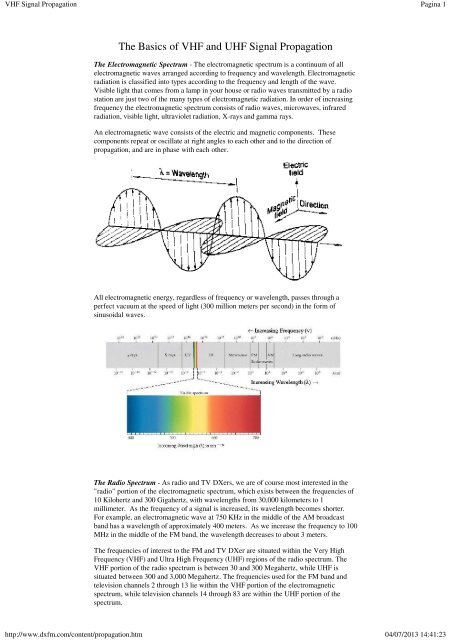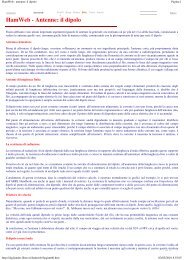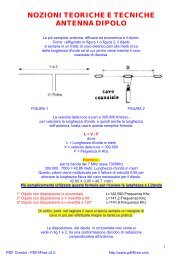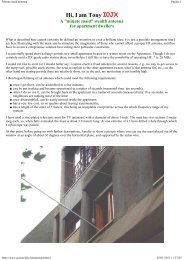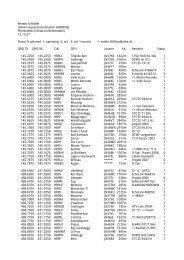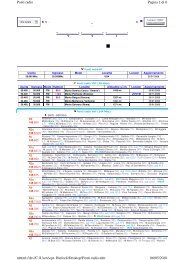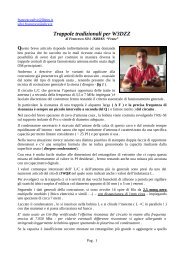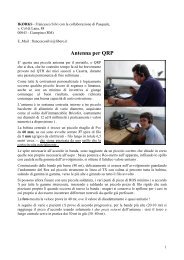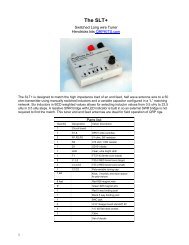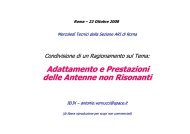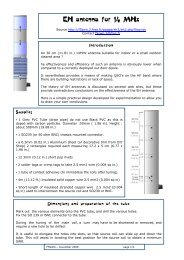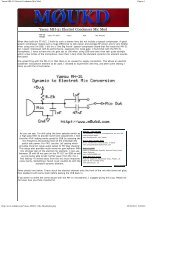VHF Signal Propagation - IN3ECI
VHF Signal Propagation - IN3ECI
VHF Signal Propagation - IN3ECI
You also want an ePaper? Increase the reach of your titles
YUMPU automatically turns print PDFs into web optimized ePapers that Google loves.
<strong>VHF</strong> <strong>Signal</strong> <strong>Propagation</strong><br />
Pagina 1<br />
The Basics of <strong>VHF</strong> and UHF <strong>Signal</strong> <strong>Propagation</strong><br />
The Electromagnetic Spectrum - The electromagnetic spectrum is a continuum of all<br />
electromagnetic waves arranged according to frequency and wavelength. Electromagnetic<br />
radiation is classified into types according to the frequency and length of the wave.<br />
Visible light that comes from a lamp in your house or radio waves transmitted by a radio<br />
station are just two of the many types of electromagnetic radiation. In order of increasing<br />
frequency the electromagnetic spectrum consists of radio waves, microwaves, infrared<br />
radiation, visible light, ultraviolet radiation, X-rays and gamma rays.<br />
An electromagnetic wave consists of the electric and magnetic components. These<br />
components repeat or oscillate at right angles to each other and to the direction of<br />
propagation, and are in phase with each other.<br />
All electromagnetic energy, regardless of frequency or wavelength, passes through a<br />
perfect vacuum at the speed of light (300 million meters per second) in the form of<br />
sinusoidal waves.<br />
The Radio Spectrum - As radio and TV DXers, we are of course most interested in the<br />
"radio" portion of the electromagnetic spectrum, which exists between the frequencies of<br />
10 Kilohertz and 300 Gigahertz, with wavelengths from 30,000 kilometers to 1<br />
millimeter. As the frequency of a signal is increased, its wavelength becomes shorter.<br />
For example, an electromagnetic wave at 750 KHz in the middle of the AM broadcast<br />
band has a wavelength of approximately 400 meters. As we increase the frequency to 100<br />
MHz in the middle of the FM band, the wavelength decreases to about 3 meters.<br />
The frequencies of interest to the FM and TV DXer are situated within the Very High<br />
Frequency (<strong>VHF</strong>) and Ultra High Frequency (UHF) regions of the radio spectrum. The<br />
<strong>VHF</strong> portion of the radio spectrum is between 30 and 300 Megahertz, while UHF is<br />
situated between 300 and 3,000 Megahertz. The frequencies used for the FM band and<br />
television channels 2 through 13 lie within the <strong>VHF</strong> portion of the electromagnetic<br />
spectrum, while television channels 14 through 83 are within the UHF portion of the<br />
spectrum.<br />
http://www.dxfm.com/content/propagation.htm<br />
04/07/2013 14:41:23
<strong>VHF</strong> <strong>Signal</strong> <strong>Propagation</strong><br />
Pagina 2<br />
<strong>Signal</strong> <strong>Propagation</strong> - When we refer to signal propagation, we are talking about the radio<br />
signal getting from one place to another, presumably from the station's transmitting<br />
antenna to the receiver's antenna. <strong>Signal</strong>s at <strong>VHF</strong> and UHF frequencies can be<br />
propagated by a variety of means or "modes". Depending on the particular mode that is<br />
dominate at the time of reception, the distances covered by <strong>VHF</strong> and UHF signals can<br />
extend hundreds or even thousands of miles. Here are some of the more common modes<br />
for <strong>VHF</strong> and UHF propagation:<br />
Ground Wave - Ground wave propagated signals are signals that, generically speaking,<br />
travel along or close to the Earth's surface on their path between the transmitting and<br />
receiving antennas. Ground wave signals are the "local" signals we receive -- the signals<br />
that are always present at your location, day and night, regardless of any any particular<br />
atmospheric or ionospheric conditions.<br />
The ground wave actually consists of two components, the surface wave and the space<br />
wave. The terms "surface wave", "space wave" and "ground wave" are often used<br />
interchangeably, even though it's not exactly correct to do so.<br />
The surface wave travels out from the transmitting antenna, remaining in contact with the<br />
Earth's surface. The surface wave is primarily responsible for the reception of local AM<br />
broadcast signals. The strength of the surface wave diminishes rapidly with distance<br />
because the Earth is a not a particularly good electrical conductor. Also, the attenuation<br />
of surface wave signals increases rapidly as the signal frequency is increased. At FM and<br />
TV frequencies the surface wave is virtually nonexistent. The surface wave is generally<br />
not a factor in our reception of FM and TV signals, local or otherwise.<br />
Reception of local FM and TV signals relies almost entirely upon the space wave<br />
component of the ground wave. The space wave signal path is the so-called "line-ofsight"<br />
path between the transmit and receive antennas. The curvature of the Earth is the<br />
primary limiting factor for the maximum distance a space wave propagated signal can<br />
travel. The space wave will travel outward from the transmitting antenna until it reaches<br />
the horizon. Beyond that point, the space wave is blocked by the Earth itself, and<br />
reception is no longer possible for a receiver located on the surface of the Earth (as most<br />
are). It's important to note, however, that the optical horizon (the horizon you can see)<br />
and the "radio horizon" are not quite the same. In reality, the space wave does not quite<br />
travel in a straight line as it moves away from the transmitting antenna. Instead, the signal<br />
travels in a slightly downward curved path that keeps it nearer to the Earth's surface, thus<br />
extending its path a little further than the optical horizon.<br />
If you are into math, the approximate distance (in miles) to the radio horizon can be<br />
calculated by multiplying the square root of the antenna height (in feet) by 1.415 times.<br />
For example, the theoretical distance to the radio horizon for an antenna 1,000 feet above<br />
the ground is just under 45 miles.<br />
The distance, D1, to the radio horizon for the transmitter is 1.415 times the square<br />
root of h1 (feet). The theoretical maximum line-of-sight distance between two<br />
elevated points, presumably the transmitter (h1) and the receiver (h2), is the sum of<br />
the two distances to the radio horizon (D1 + D2).<br />
All this, of course, assumes that the Earth is a perfectly smooth sphere, and that no signal<br />
disturbances or enhancements occur along the path between the transmit and receive<br />
points. As we know, the Earth is not a perfect sphere, and the space through which the<br />
radio signal travels is not perfect either. FM and TV signals can be either attenuated or<br />
enhanced by various path imperfections. Hills, buildings, trees and other physical<br />
obstacles along the signal path often reduce FM and TV reception distance. On the other<br />
hand, a variety of atmospheric and ionospheric conditions serve to enhance our FM and<br />
TV reception distance. We will concentrate on the enhancements that make it possible<br />
for <strong>VHF</strong> and UHF signals to travel hundreds and even thousands of miles.<br />
Refraction, Refraction, Refraction - Refraction is defined as "...a change in direction of<br />
a wave as it crosses the boundary that separates one medium from another." While this<br />
may sound a little imposing, it's really a simple principle of physics -- one that we<br />
http://www.dxfm.com/content/propagation.htm<br />
04/07/2013 14:41:23
<strong>VHF</strong> <strong>Signal</strong> <strong>Propagation</strong><br />
Pagina 3<br />
probably observe daily. Refraction, in one form or another, is the primary mechanism<br />
that enables long-distance FM and TV reception.<br />
Refraction explains the apparent "bending" of an<br />
object when it is partly immersed in water and<br />
viewed from above the surface.<br />
As stated earlier, a radio wave travels through a perfect vacuum at the speed of light (300<br />
million meters per second). However, when the medium through which the wave travels<br />
is not a perfect vacuum, the wave's travel is slowed. For example, an electromagnetic<br />
wave travels slower through air or water than it does through a perfect vacuum.<br />
Refraction comes into play when a wave enters a new medium at an angle of less than<br />
90°. As the wave enters the new medium, a change in the wave's speed occurs sooner on<br />
one side of the wave than on the other. This causes the wave's direction of travel to be<br />
bent.<br />
Under normal conditions, a signal that is not blocked or obstructed simply travels in a<br />
straight line out into space, never to return to Earth again. However, various atmospheric<br />
conditions often cause the normal path of FM and TV signals to be bent downward,<br />
returning the signal to the surface of the Earth, sometimes a great distance from its point<br />
of origin.<br />
Tropospheric Enhancements - Within the broad classification of tropospheric<br />
enhancement, there are several different and distinct propagation modes that make it<br />
possible for FM and TV signals to travel far greater distances than the normal radio lineof-sight<br />
horizon.<br />
Tropospheric Scatter - Tropospheric scatter is the most common form of tropospheric<br />
enhancement. Tropo-scatter is always present to some degree just about everywhere.<br />
Tropospheric scatter at FM and TV frequencies is caused when the paths of radio signals<br />
are altered by slight changes in the refractive index in the lower atmosphere caused by air<br />
turbulence, and small changes in temperature, humidity and barometric pressure. The<br />
signal is scattered in random fashion. The tiny portion of the transmitted signal that is<br />
scattered forward and downward from what is called the "common scattering volume" is<br />
responsible for signal paths longer than the normal line-of-sight horizon.<br />
http://www.dxfm.com/content/propagation.htm<br />
04/07/2013 14:41:23
<strong>VHF</strong> <strong>Signal</strong> <strong>Propagation</strong><br />
Pagina 4<br />
Geometry of Tropo-Scatter <strong>Signal</strong> <strong>Propagation</strong><br />
The height of the scattering volume that is common to both the transmitting and receiving<br />
stations determines the maximum tropo-scatter path distance. Above about 6 miles<br />
refraction in the troposphere becomes insufficient to return any signal to Earth.<br />
Tropo-scatter enables the reception of signals from out to about 500 miles, depending<br />
primarily on the the power of the transmitting station and the quality of the receiving<br />
equipment being used. Maximum tropo-scatter path distances of 200 to 300 are more<br />
typical on a day-to-day basis. Tropo scattered signals are characteristically weak,<br />
"fluttery" signals that often suffer from random fading.<br />
Tropospheric Refraction - The "standard" atmosphere is defined as air at sea level having<br />
a temperature of 59° F, a barometric pressure of 29.92 inches of mercury, and a density of<br />
0.002378 slugs per cubic foot. As we increase altitude within our standard atmosphere,<br />
the temperature, pressure and density decrease at fixed rates. The U.S. version of the<br />
standard atmosphere table for altitudes up to 10,000 feet looks like this...<br />
True Altitude<br />
above mean sea<br />
level<br />
Barometric Pressure<br />
inches of mercury<br />
Temperature<br />
Fahrenheit<br />
Density<br />
slugs per cubic foot<br />
0 29.92 59.0 0.002378<br />
1,000 28.86 55.4 0.002309<br />
2,000 27.82 51.9 0.002242<br />
3,000 26.82 48.3 0.002176<br />
4,000 25.84 44.7 0.002112<br />
5,000 24.89 41.2 0.002049<br />
6,000 23.98 37.6 0.001988<br />
7,000 23.09 34.0 0.001928<br />
8,000 22.22 30.5 0.001869<br />
9,000 21.38 26.9 0.001812<br />
10,000 20.57 23.3 0.001756<br />
As stated previously, when a wave enters a new medium at an angle of less than 90°, the<br />
change in speed occurs sooner on one side of the wave than on the other, causing the<br />
wave to bend. Close to Earth, the medium through which radio waves travel is air. The<br />
air through which the radio wave travels is an ever changing medium due to changes in<br />
temperature, barometric pressure and density. The "refractive index" of air in a standard<br />
atmosphere is sufficient to bend a radio signal ever so slightly downward, accounting for<br />
the fact that "line-of-sight" signals travel just a little further than the optical horizon.<br />
http://www.dxfm.com/content/propagation.htm<br />
04/07/2013 14:41:23
<strong>VHF</strong> <strong>Signal</strong> <strong>Propagation</strong><br />
Pagina 5<br />
An illustration of why refracted signals go further than the optical line-of-sight.<br />
What happens when the atmosphere does not follow the standard model? Let's say<br />
everything is "normal" until we get to 4,000 feet, where we encounter a rise in<br />
temperature instead of the normal decrease -- a condition known as a temperature<br />
inversion. The sudden discontinuity in the medium through which our radio wave travels<br />
will have a higher refractive index than our standard atmosphere model. In other words,<br />
our radio signal will be bent at a sharper angle where it encounters the discontinuity. If<br />
the bending is in a downward direction (back toward the surface of the Earth), the normal<br />
range of the radio signal will be extended.<br />
Various weather conditions increase the refractive index of the atmosphere, thus<br />
extending signal propagation distances. Stable signals with good signal strength from<br />
500+ miles away are not uncommon when the refractive index of the atmosphere is fairly<br />
high.<br />
Tropospheric Ducting - This is where things start getting interesting for the FM and TV<br />
DXer. Strong temperature inversions with very well defined boundaries sometimes form<br />
from as high as several thousand feet above the surface of the Earth. If the inversion is<br />
strong enough, a signal crossing the boundary into the inversion will be bent sufficiently<br />
to return it to Earth. The inversion boundary layer and the surface of the Earth form the<br />
upper and lower walls of a "duct" that acts much like an open-ended wave guide. <strong>Signal</strong>s<br />
"trapped" in the duct follow the curvature of the Earth, sometimes for hundreds or even<br />
thousands of miles. In the tropics and over large bodies of water, strong inversions that<br />
cover large geographic areas are quite common, and stable ducts can remain in tact for<br />
days on end. This form of ducting is responsible for fairly reliable propagation between<br />
California and Hawaii at <strong>VHF</strong> and higher frequencies.<br />
An illustration of tropospheric ducting.<br />
While somewhat less common, ducts sometimes form between atmospheric boundary<br />
layers at much higher altitudes, with the upper boundary having an altitude as high as<br />
10,000 feet or more. The upper refractive layer bends signals downward, while the lower<br />
refractive boundary bends the signals upward, forming a signal-trapping duct that acts<br />
much like a wave guide. When this condition exists, FM band signals can travel<br />
thousands of miles. Indeed, there is no theoretical limit to the distance a signal can travel<br />
via tropospheric ducting. With respect to the receiving station, tropospherically ducted<br />
signals will usually come from a geographically selective area. A distant station may be<br />
heard in favor of a closer station on the same frequency. Sometimes conditions are such<br />
that multiple ducts form, bringing in distant stations from many different areas at the<br />
same time.<br />
http://www.dxfm.com/content/propagation.htm<br />
04/07/2013 14:41:23
<strong>VHF</strong> <strong>Signal</strong> <strong>Propagation</strong><br />
Pagina 6<br />
An illustration of a high-altitude tropospheric duct.<br />
An interesting characteristic of this form of ducting is that both the transmitting and<br />
receiving antennas must be inside of the duct to gain the maximum signal enhancement.<br />
A receiving antenna located outside of the duct will hear little or no signal from a<br />
transmitting antenna located inside the duct. For this type of duct to be useful to us, the<br />
signal must get in and exit the duct somewhere along the signal path. This can occur if<br />
the ends of a duct are open at each end, or through "holes" that form along the bottom<br />
layer of the duct.<br />
A basic principal of radio is that the wavelength of a signal gets shorter as the frequency<br />
of the signal is increased. Because of this, the size of the tropospheric duct determines<br />
the lowest signal frequency that it can successfully propagate. This is knows as the<br />
Lowest Usable Frequency or LUF of the duct. A physically small duct, a duct with its<br />
upper and lower boundaries close together, will propagate only higher frequency signals<br />
with very short wavelengths. As the distance between the boundaries of the<br />
duct increases, the signal frequency the duct will propagate decreases. In other words, a<br />
larger duct will accommodate a lower frequency signal having a physically longer<br />
wavelength. It's possible for a duct to form that only supports signal propagation at UHF<br />
television frequencies, while not effectively passing anything in the <strong>VHF</strong> television or FM<br />
bands.<br />
Ducted signals from 900 - 1,000 miles are fairly common, but it's more common for<br />
ducted signals to travel 500 - 800 miles. Ducted signals are typically quite strong,<br />
sometimes so strong that they can cause interference to local signals on the same<br />
frequency.<br />
Weather Suitable for a Duct - Tropospheric ducting most often occurs because of a<br />
dramatic increase in temperature at higher altitudes. If the temperature inversion layer<br />
has a lower humidity than the air below or above it, the refractive index of the layer will<br />
be enhanced further. There are several common weather conditions that often bring about<br />
strong temperature inversions.<br />
While not usually the cause of strong ducting, radiation inversions can bring about<br />
pronounced signal enhancement, extending the DX range up to a few hundred miles.<br />
This is probably the the most common and widespread form of inversion a DXer is likely<br />
to encounter on a regular basis.<br />
A radiation inversion forms over land after sunset. The Earth cools by radiating heat into<br />
space. This is a progressive process where the radiation of surface heat upwards causes<br />
further cooling at the Earth's surface as cooler air moves in to replace the upward moving<br />
warm air. At higher altitudes the air tends to cool more slowly, thus setting up the<br />
inversion. This process often continues all the way through the night until dawn,<br />
sometimes producing inversion layers at 1,000 to 2,000 feet above the ground.<br />
Radiation inversions are most common during the summer months on clear, calm nights.<br />
The effect is diminished by blowing winds, cloud cover and wet ground. Radiation<br />
inversions are often more pronounced in dry climates, in valleys and over large expanses<br />
of flat, open ground.<br />
Another meteorological process called "subsidence" often produces strong ducting<br />
conditions and excellent DX. Subsidence is the process of sinking air that becomes<br />
compressed and heated as it descends. This process often causes strong temperature<br />
inversions to form at altitudes ranging from 1,000 feet to as high as 10,000 feet.<br />
Subsidence is commonly produced by large, slow-moving high-pressure zones<br />
(anticyclones). These almost stationary high-pressure zones often form over the eastern<br />
half of the United States during the late summer and early fall months. They usually<br />
move out of Canada, traveling toward the southeast. As the high-pressure zone stalls over<br />
http://www.dxfm.com/content/propagation.htm<br />
04/07/2013 14:41:23
<strong>VHF</strong> <strong>Signal</strong> <strong>Propagation</strong><br />
Pagina 7<br />
the Midwest, strong inversions form, bringing outstanding 1,000+ mile DX that can last<br />
for days at a time. This condition is most common in the Southeastern states and lower<br />
Midwest. It also shows up from time to time in the upper Midwest and East Coast states.<br />
It rarely shows up in the Western states.<br />
The following weather maps are from September 5 and 6 of 2001. They provide a realworld<br />
illustration of tropospheric ducting associated with a slow moving high-pressure<br />
zone.<br />
On September 5th, 2001, a very slow moving high-pressure zone was pushing out of<br />
Canada toward the southeast. As the high was centered over Northern Michigan, we<br />
observed excellent tropospheric DX conditions here in Lexington, Kentucky. Strong FM<br />
and TV signals out of Minnesota, North and South Dakota, Iowa, and Illinois were<br />
plentiful throughout the day. <strong>Signal</strong>s from 800-900 miles were common.<br />
On September 6, 2001, a full 24 hours later, the sluggish high pressure zone had moved<br />
only as far as western New York. Here in Lexington, our DX zone had expanded east.<br />
The 800-900 mile TV and FM signals from the Midwest were still present, but strong<br />
signals from the Northeast as far away as central Ontario were also added to the mix.<br />
This excellent DX "opening" lasted almost a full 48 hours.<br />
In the northern hemisphere, the strongest signals and longest signal paths will usually be<br />
observed to the south of the high-pressure center. In the southern hemisphere, the reverse<br />
is true -- the best signal paths will be to the north of the high-pressure center. Subsidence<br />
ducting is often intensified during the evening and early morning hours when the effects<br />
of radiation inversions are added to the mix.<br />
http://www.dxfm.com/content/propagation.htm<br />
04/07/2013 14:41:23
<strong>VHF</strong> <strong>Signal</strong> <strong>Propagation</strong><br />
Pagina 8<br />
Well positioned warm and cold fronts sometimes bring about ducting and enhanced DX<br />
conditions.<br />
A warm front is the surface boundary between a mass of warm air flowing over an area of<br />
cooler, relatively stationary air. Enhanced DX conditions will often be observed out to<br />
approximately 100 miles ahead of the advancing front. The best paths will be along a line<br />
parallel to the frontal boundary.<br />
Likewise, cold fronts can also produce some nice DX conditions. A cold front is the<br />
surface boundary between a mass of cooler air that pushes itself under a mass more<br />
stationary warm air. This forces the warm air up and behind the advancing front. The<br />
ducts produced by a passing cold front are often unstable. The best signal paths will be<br />
behind and along a line that's parallel to the advancing front.<br />
On November 9, 2001, this cold front and well-positioned high-pressure zone (over<br />
southeast Kansas) produced a full day of outstanding tropospheric FM and TV DX here in<br />
Lexington. We were solidly open to Arkansas, Alabama, Louisiana and Mississippi. Path<br />
distances were upwards of 600 miles with very strong signals.<br />
On December 7, 2001, this well positioned cold front produced excellent DX paths into<br />
eastern Tennessee. This very geographically selective opening didn't produce very long<br />
signal paths, but even low power stations were heard with very strong signals.<br />
Since the tropospheric enhancements we've covered so far are all weather related, you<br />
can see why it's important for the DXer to pay attention to day-to-day weather conditions.<br />
http://www.dxfm.com/content/propagation.htm<br />
04/07/2013 14:41:23
<strong>VHF</strong> <strong>Signal</strong> <strong>Propagation</strong><br />
Pagina 9<br />
Sporadic E - This is probably the most interesting and exciting forms of signal<br />
enhancement for the FM and TV DXer. Highly ionized patches or "clouds" occasionally<br />
form in the E region of the ionosphere at altitudes between approximately 50 and 70<br />
miles. We call these sporadic E clouds. Sporadic E clouds are usually fairly small in size,<br />
but larger clouds or multiple clouds often form during substantial openings. These clouds<br />
often, but not always, travel from their point of origin to the north and northwest at<br />
speeds up to several hundred miles per hour.<br />
It's interesting to note that after almost 70 years of study the true cause for sporadic E is<br />
still unknown. There are many different theories as to how and why sporadic E clouds<br />
form.<br />
It was once believed that the formation of sporadic E clouds was directly related to the<br />
eleven year solar (sunspot) cycle. You'll still see that theory expressed in some text books<br />
even though overwhelming evidence suggests that this belief is wrong. There seems to be<br />
no correlation between the ionization level or formation of sporadic E clouds and the<br />
eleven year sunspot cycle - at least not in the mid latitudes away from the geomagnetic<br />
equator and poles. It was noted all the way back in the 1930s and 1940s that the<br />
formation and intensity of mid-latitude sporadic E clouds does not substantially vary over<br />
the course of the eleven year solar cycle.<br />
There is evidence to suggest that the primary cause of sporadic E cloud formation is wind<br />
shear, a purely weather-related phenomenon. Intense high altitude winds, traveling in<br />
opposite directions at different altitudes, produce wind shear. It is believed that these<br />
wind shears, in the presence of Earth's geomagnetic field, cause ions to be collected and<br />
compressed into a thin, ion-rich layers, approximately one-half to one mile in thickness.<br />
The area of these patches can vary from a few square miles to hundreds or even thousands<br />
of square miles.<br />
Along the same line is the theory that sporadic E clouds are formed in the vicinity of<br />
thunderstorms by the intense electrical activity associated with the storm. There is often<br />
(but not always) a correlation between thunderstorm activity and the formation of sporadic<br />
E clouds, enough to make this theory very tantalizing. However, strong thunderstorms<br />
often form along frontal boundaries, and intense wind sheer is usually found along the<br />
same frontal boundaries that produce thunderstorms. Likewise, strong sporadic E activity<br />
often appears when there is no apparent thunderstorm activity along or near the<br />
propagation path.<br />
Yet another emerging theory suggests that sporadic E clouds are formed by concentrations<br />
of meteoric debris. Again, there seems to be a strong correlation between meteor shower<br />
activity and the number and intensity of sporadic E clouds.<br />
The point is, nobody has presented a definitive explanation for how and why sporadic E<br />
clouds form. There are many excellent papers on the subject. Just enter "sporadic E" into<br />
your favorite search engine, and start reading. It's entirely possible (perhaps even likely)<br />
that sporadic E clouds are formed as the result of a combination of factors, perhaps<br />
involving wind shear, cosmic debris and thunderstorm activity.<br />
The amount by which the path of a radio signal is refracted by sporadic E clouds depends<br />
on the intensity of ionization and the frequency of the signal. For a given level of<br />
ionization, the signal refraction angle will decrease as the frequency is increased. Above<br />
a certain critical frequency, refraction of the signal will be insufficient to return it to the<br />
surface of the Earth. This critical frequency is known as the Maximum Usable Frequency<br />
or MUF.<br />
Sporadic E is very common on the low <strong>VHF</strong> TV channels during the summer months.<br />
From time to time, the intensity of Sporadic E cloud ionization increases to the point<br />
where the MUF rises into and sometimes above FM band frequencies (88 to 108 MHz). It<br />
is common for the MUF to rise up to and then stop at a particular frequency within the<br />
FM band. Distant signals will be heard below the MUF, while only local or<br />
tropospherically enhanced signals will be heard above the MUF. It has been observed<br />
over the years that the signal strength of received sporadic E signals will be greatest just<br />
below the Maximum Usable Frequency. Also, since the bending angle (angle of<br />
refraction) decreases as signal frequency is increased for a given ionization level, we can<br />
surmise that the most distant receptions will occur as we approach the MUF. In other<br />
words, an Es cloud will support longer signals paths at 100 MHz than it will at 50 MHz.<br />
http://www.dxfm.com/content/propagation.htm<br />
04/07/2013 14:41:23
<strong>VHF</strong> <strong>Signal</strong> <strong>Propagation</strong><br />
Pagina 10<br />
The above illustration shows an actual Es cloud configuration and the associated skip<br />
zone that occurred during the summer of 2001. Three different DXers are represented by<br />
the numbers 1, 2 and 3. The Es cloud was over Eastern Kansas and Western Missouri.<br />
The yellow band is the DX zone. Using the same sporadic E cloud, a DXer in one part of<br />
the country will hear one assortment of stations while a DXer in a different part of the<br />
country will hear a completely different set of stations. If the DXers were to plot lines<br />
between their respective locations and the stations they were each hearing (as I did here),<br />
the approximate location of the sporadic E cloud will be above where the lines intersect.<br />
You will note that both the DXer and the stations being received are in the yellow shaded<br />
DX zone. DXers outside the yellow shaded zone did not benefit from this particular Es<br />
cloud.<br />
DXer #1 (me), located in Lexington, KY, heard stations in New Mexico and Colorado.<br />
DXer #2, in West Texas heard stations in Wisconsin and Michigan. DXer #3, located in<br />
Western South Dakota heard stations in Mississippi and Alabama.<br />
Es signal paths are usually bi-directional. In other words, if the DXer in Kentucky is<br />
hearing FM stations in Colorado, a DXer in Colorado will be able to hear stations in<br />
Kentucky.<br />
Since Es clouds often move with respect to the receiving station, the DXer will often hear<br />
a changing selection of distant signals.<br />
Various geometries of Sporadic E <strong>Signal</strong> <strong>Propagation</strong><br />
This illustration shows three sporadic E clouds. Cloud #1 is more intensively ionized,<br />
and is thus capable of refracting signals at a sharper angle, producing a shorter skip<br />
distance for a given frequency. <strong>Signal</strong>s being refracted by Cloud #2 are returned to Earth<br />
at a lesser angle, thus producing longer skip distances. With clouds #2 and #3 in<br />
alignment along the signal path, "double-hop" skip can occur. With this cloud alignment<br />
signals from both the "transmitter" and the "Single-Hop Zone" would be heard at the<br />
receiver location.<br />
A sporadic E cloud producing short to medium distance skip at lower frequencies (TV<br />
channel 2, for example) is likely to produce longer skip at FM frequencies if the MUF is<br />
high enough.<br />
The maximum distance for a single-hop sporadic E propagated signal is approximately<br />
1,500 miles. However, if multiple, sufficiently ionized patches exist in a line along a<br />
particular signal path, it's possible for a given signal to reflect off the surface of the Earth<br />
http://www.dxfm.com/content/propagation.htm<br />
04/07/2013 14:41:23
<strong>VHF</strong> <strong>Signal</strong> <strong>Propagation</strong><br />
Pagina 11<br />
after the first hop and get refracted back to Earth by a second sporadic E cloud. This can<br />
extend the range of E-layer propagated signals out to 3,000 miles and beyond.<br />
Statistically speaking, the "average" skip distance for sporadic E propagated FM DX<br />
seems to be between 950 and 1,050 miles. During 2001 I received 205 stations via<br />
sporadic E (a decent statistical sample). The average distance of these receptions was 997<br />
miles.<br />
Single-hop E-layer propagated signals are often as strong as local signals. Indeed, I have<br />
witnessed more than one situation where a local station was completely "covered" by a<br />
distant one, only a few miles from the local station's transmitter location (that's when they<br />
call the engineer to see if he can "fix" the problem). Since the surface of the Earth is not<br />
a very good signal reflector, multi-hop E-layer propagated signals will usually be weaker<br />
than single-hop signals, and are often covered by signals coming from stations in the<br />
single hop zone. If the mid-point of a double-hope happens to be on water (such as the<br />
ocean), the signals will be stronger and the there will likely be no interference from midpoint<br />
stations (unless someone happens to be operating an FM or TV broadcast station<br />
aboard a ship!).<br />
Sometimes we hear stations via Sporadic E that don't seem to fit the normal model in<br />
terms of path distance. It's not uncommon to receive signals beyond the range of what<br />
would be considered "normal" for a single hop, but at less than the range expected for<br />
"normal" double hop.<br />
Many theories have been advanced to explain this phenomenon, including paths along<br />
multiple, tilted sporadic E clouds. Here's an illustration of how this might work.<br />
Geometry of "Tilted" Es Cloud-to-Cloud <strong>Signal</strong> <strong>Propagation</strong><br />
Based on both Earth and satellite based ionosonde readings and readings from rockets<br />
sent through Es clouds, it is known that tilted Es clouds do form. As such, this theory<br />
does provide at least one plausible explanation for longer than "normal" Es signal<br />
propagation paths.<br />
I think there is another, simpler means by which Es signals are propagated longer than<br />
"normal" distances out to almost double-hop distances. This would also account for<br />
receptions where signals from double-hop distances are received without the usual<br />
interference from stations in the single hop zone.<br />
Geometry of "Non-Tilted" Es Cloud-to-Cloud <strong>Signal</strong> <strong>Propagation</strong><br />
In this illustration, neither Es cloud is sufficiently ionized to return a single-hop signal to<br />
Earth. However, with the two "weak" clouds working together, the refraction angles of<br />
each Es cloud are essentially added. This would have the effect of raising the apparent<br />
Maximum Usable Frequency and ultimately returning the signal to Earth at a greater than<br />
"normal" Es distance. This is a somewhat more simple (thus more likely) Es cloud<br />
configuration than that of the "tilted" cloud theory. It would account for variable path<br />
http://www.dxfm.com/content/propagation.htm<br />
04/07/2013 14:41:23
<strong>VHF</strong> <strong>Signal</strong> <strong>Propagation</strong><br />
Pagina 12<br />
distances which fall between that of "normal" single- and double-hop sporadic E path<br />
distances.<br />
In theory, a similar configuration could exist with three or more Es clouds, producing<br />
much longer signal paths. However, as the complexity of the signal path geometry<br />
increases, the likelihood of such configurations forming and becoming usable diminishes.<br />
Other Es cloud configurations are certainly possible. Picture, for example, a larger<br />
sporadic E cloud, which is not uniformly ionized...<br />
Possible Path Geometry of a Large Es Cloud with Non-uniform Ionization<br />
A signal entering the "weaker" side of the large Es cloud does not return to Earth.<br />
Instead, it is propagated to a part of the Es cloud that is more intensely ionized. Ionization<br />
in this region of the Es cloud is sufficient to return the signal to Earth. The effect of such<br />
a configuration is not fundamentally different than the tilted cloud or cloud-to-cloud<br />
examples presented above. It is another possible means by which Es signals can be<br />
propagated longer than "normal" single-hop distances.<br />
In the northern hemisphere, seasonal sporadic E season peaks occur during the months of<br />
May, June and July. An additional minor peak often occurs in late December around<br />
Christmas time when the Sporadic E season is at its summertime peak in the southern<br />
hemisphere. One theory to explain this phenomenon is that intense sporadic E clouds<br />
formed in the vicinity of the equator manage to hold their configuration as they drift<br />
toward the north and northwest, thus producing our short December sporadic E DX<br />
season. The best time of day for sporadic E seems to be mid morning and mid<br />
afternoon. However, sporadic E DX can happen at anytime, day or night, and can pop up<br />
any time of the year. Sporadic E DX usually lasts from a few minutes to a few hours.<br />
However, I've seen it last several full days and nights, causing a great lack of sleep!<br />
Aurora Effect - During periods of high solar and geomagnetic activity, aurora or<br />
"northern lights" may be present. FM signals can be returned to Earth from the auroral<br />
curtain. However, the constantly varying intensity of the aurora and its highly variable<br />
reflectivity give auroral propagated signals a fluttery quality. The flutter will usually be in<br />
the range of 100 Hz to 2,000 Hz, producing a "buzz" in the received signal. In some<br />
cases, this effect can be so strong, normal voice or music modulation ends up becoming<br />
distorted to the point of unintelligibility. In the northern hemisphere, auroral propagated<br />
signals will generally come from the north, regardless of the true direction of the<br />
transmitting station.<br />
Look for aurorally-propagated signals following major<br />
solar activity, or the announcement that visible northern<br />
lights will be seen near your area. Obviously, the<br />
further south you live, the less likely you are to hear<br />
auroral enhanced radio signals. The best place for<br />
auroral effect in the United States is in Alaska or the<br />
Northeastern states. It'll be rare below latitude 32 in<br />
the Southeast and latitude 38 to 40 in the West and<br />
Southwest.<br />
The theoretical maximum distance for Auroral enhanced signals is about 1,300 miles. 200<br />
to 800 miles is typical. High quality, very sensitive, receiving equipment is required for<br />
this DX mode.<br />
Meteor Scatter - This interesting form of enhancement results from signals bouncing off<br />
of the intensely ionized trails of meteors entering and "burning up" in the E region of the<br />
http://www.dxfm.com/content/propagation.htm<br />
04/07/2013 14:41:23
<strong>VHF</strong> <strong>Signal</strong> <strong>Propagation</strong><br />
Pagina 13<br />
ionosphere. The strength and duration of meteor scatter signals decreases with increasing<br />
frequency. Thus, the effect is much more pronounced at the lower FM band frequencies<br />
than at the upper end of the band. Meteor scatter can be heard anywhere, anytime of the<br />
day or night. However, bursts are more plentiful around dawn, and during known major<br />
meteor showers.<br />
The radio signal returns to Earth after bouncing off the meteor trail.<br />
Meteor scatter is characterized by a sudden, short burst of a distant, strong signal. The<br />
length of the burst depends upon the length and intensity of the ionized meteor trail.<br />
They can be as short as a fraction of a second, producing a short "ping" at the receiver.<br />
Larger meteors, or meteors entering atmosphere at a glancing angle, have been known to<br />
produce signal bursts lasting up to several minutes. If you try, you'll hear many meteor<br />
scatter signals. However, you have to be lucky to actually catch a station identification at<br />
exactly the same instant the meteor burst occurs. High quality equipment helps, but<br />
meteor bursts can even be heard on the "average" car radio if you know what to listen<br />
for..<br />
Summary - There are other, more esoteric signal propagation modes that are often at<br />
work to enhance long-distance reception of FM signals. <strong>Signal</strong>s bounce off of airplanes<br />
and even formations of birds. With the right equipment, it's even theoretically possible to<br />
recover broadcast signals bounced off the surface of the moon! However, the propagation<br />
modes outlined above are the more common ones you are likely to encounter while FM<br />
DXing.<br />
Note: All the propagation mode illustrations shown here, are obviously not drawn to<br />
scale. The signal "bending" angles shown are very exaggerated. In reality, they are<br />
usually fairly slight angles.<br />
http://www.dxfm.com/content/propagation.htm<br />
04/07/2013 14:41:23


